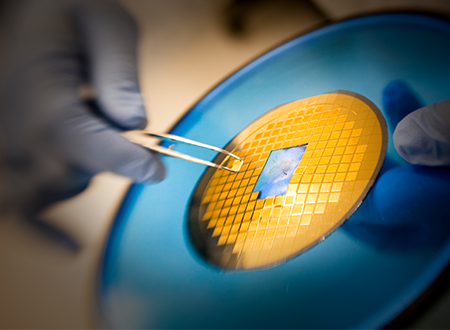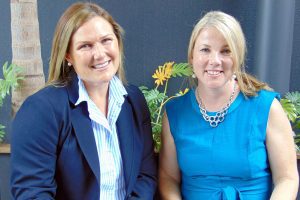Smaller than a postage stamp and covered in vaccine-coated microscopic projections, the Nanopatch promises to save the lives of millions of people worldwide by giving them access to safe, effective and needle-free vaccinations.
Professor Mark Kendall was all set for a career in aerodynamics when he met a man with an unusual idea: he wanted to use rocket technology to fire vaccines into the skin. Intrigued, Kendall accepted the man’s offer to work at Oxford University, where together with others they developed the ‘gene gun’ – a device that used aerodynamic principles to deliver vaccines to the skin.
That was almost 20 years ago. Kendall has since moved back to Australia and pushed beyond the gene gun technology, creating the Nanopatch, a new and unique way to administer life-saving vaccines that is safer and more effective than using a needle and syringe.
The Nanopatch is a tiny piece of silicon, covered on one side with up to 20,000 microscopic projections per square centimetre. Each of these projections is coated in a dry vaccine. When the patch is applied, these projections deliver the vaccine just below the top layer of the skin, which is abundant in immune cells. Within about a minute, the vaccine becomes wet in the cellular environment and is released.
Animal testing has shown that the Nanopatch delivers similarly protective immune responses as the needle and syringe, with significantly lower doses of vaccine. Using dry vaccines also means there is no need for refrigeration. Being needle-free, there is mitigated risk of cross-contamination or injuries. Needle-phobic people can also rejoice: the patch delivery method promises to be painless.
“The Nanopatch has the potential to completely change the way vaccines are delivered and address ongoing problems in the global push for vaccines in the developing world,” said Kendall, Group Leader, The Australian Institute for Bioengineering and Nanotechnology at The University of Queensland.
From aerodynamics to immunology
Originally a mechanical engineer with a PhD in hypervelocity aerodynamics – “I was researching high-speed wind tunnels for interplanetary missions” – Kendall’s interest in immunology stemmed from his time at Oxford working on the gene gun.
Immunologists had discovered there were thousands of immune cells just under the surface of the skin. Instead of injecting deep into muscle where there are fewer immune cells, why not administer vaccines to the skin? There was only one problem: the technology to effectively do this did not exist – until Kendall came along.
“As an engineer with a knowledge of immunology, I looked at the scale of the cells, their spatial position and how quickly they moved,” said Kendall.
“That fresh thinking allowed me to come up with the idea of using an array of nano-projections to deliver vaccines to those cells. For the array to work, you need a base on which to attach the projections and that was the silicon patch.”
More effective vaccines that don’t need refrigeration
The Nanopatch has two major advantages over traditional vaccination methods. The first is improved immunogenicity. In 2015, Kendall’s team, in collaboration with the World Health Organization (WHO) and the US Centres for Disease Control and Prevention, tested an inactivated poliovirus vaccine on rats using the Nanopatch. They found they needed 40 times less vaccine to generate the same functional immune response as the needle and syringe.
“Many of the new-generation vaccines are expensive, multi-dose medicines that are difficult to make,” said Kendall. “The Nanopatch, when proven in humans, has tremendous potential to reduce manufacturing costs because we will need less vaccine to induce a protective immune response.”

Smaller than a postage stamp, the Nanopatch promises to save the lives of millions of people.
Kendall hopes the Nanopatch can become a vehicle to make vaccines work better in the developing world.
The Nanopatch has been tested in animals on vaccines for influenza, HPV, polio, malaria, HSV-2, chikungunya, West Nile virus and pneumococcus – all diseases plaguing developing nations.
Of the 14 million people who die of infectious diseases every year, the majority are in developing countries, where people are not able to receive effective vaccines that exist for others, or they die from diseases that still do not have adequate vaccination methods.
“The Nanopatch could potentially help on both fronts,” said Kendall. “It can bridge that ‘last mile’ to get effective vaccines to people who aren’t receiving them, and through its improved immunogenicity, could help candidate vaccines for diseases such as malaria to get over the line and be effective.” It may also be possible for people to self-administer the vaccine.
Moreover, unlike liquid vaccines that need to be kept cold from production to application, the Nanopatch does not require refrigeration. Lab tests have shown the dry vaccine can be stored at 23 degrees Celsius for more than a year without any loss of activity – a significant benefit in regions where vaccines have to travel long distances to reach their destination and where there may be no electricity to keep them cold.
Clinical trials underway
In 2011, Kendall founded Vaxxas to develop and commercialise the Nanopatch, raising A$15 million in first-round funding – one of Australia’s largest-ever investments in a startup biotechnology company. Four years later, it raised A$25 million, the proceeds of which was used to advance a series of clinical programs and develop a pipeline of new vaccine products for major diseases.
Vaxxas has also forged a partnership with American pharmaceutical company Merck to evaluate, develop and commercialise the Nanopatch for vaccine candidates. In 2014, Vaxxas was selected as a World Economic Forum Technology Pioneer based on the potential of the Nanopatch to improve health on a global scale.
The Nanopatch is currently undergoing clinical trials. The WHO will also conduct clinical tests to determine the utility of the Nanopatch for polio vaccinations. Concurrently, Vaxxas is determining if the Nanopatch can be manufactured in large numbers at low cost. All things going well, Kendall said the Nanopatch may be commercially available by 2020.
For his pioneering work, Kendall has received a raft of awards, most recently the 2016 Dr John Dixon Hughes Medal for Medical Research Innovation and the 2016 CSL Young Florey Medal, one of Australia’s highest science honours.
But Kendall will not rest until the Nanopatch is in the field.
“Vaccines will continually be improved; there will be new vaccines coming out for diseases that don’t currently have adequate vaccination strategies and improved vaccines for the ones that do,” he said.
“I’m not going to be satisfied until we’ve rolled the Nanopatch out, taken it out of the lab and got it to people in large numbers, particularly the people who need it the most.”

Mark Kendall with the Nanopatch.
Find out more about The Australian Institute for Bioengineering and Nanotechnology at the University of Queensland.
Find out more about Vaxxas.
This article was originally published on Australia Unlimited and is republished here under Creative Commons.





















Add Comment